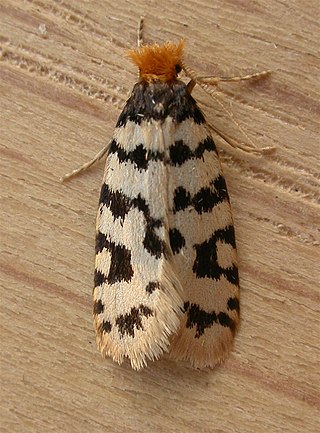
The Psychidae are a family of the Lepidoptera. The bagworm family is fairly small, with about 1,350 species described. Bagworm species are found globally, with some, such as the snailcase bagworm, in modern times settling continents where they are not native.
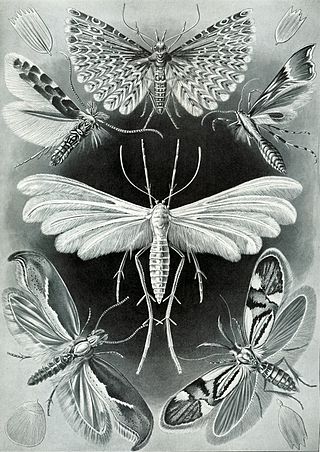
Microlepidoptera (micromoths) is an artificial grouping of moth families, commonly known as the "smaller moths". These generally have wingspans of under 20 mm, so are harder to identify by external phenotypic markings than macrolepidoptera. They present some lifestyles that the larger Lepidoptera do not have, but this is not an identifying mark. Some hobbyists further divide this group into separate groups, such as leaf miners or rollers, stem or root borers, and then usually follow the more rigorous scientific taxonomy of lepidopterans. Efforts to stabilize the term have usually proven inadequate.
The wattle bagworm is a species of moth in the family Psychidae. In southern Africa it is a pest of the black wattle which is grown largely as a source of vegetable tannin. Kotochalia junodi is indigenous to Southern Africa, where it originally fed on indigenous relatives of the wattle.

The Mediterranean flour moth or mill moth is a moth of the family Pyralidae. It is a common pest of cereal grains, especially flour. This moth is found throughout the world, especially in countries with temperate climates. It prefers warm temperatures for more rapid development, but it can survive a wide range of temperatures.
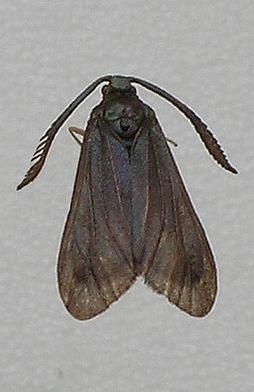
The levuana moth is an extinct species of moth in the family Zygaenidae. It is monotypic within the genus Levuana.
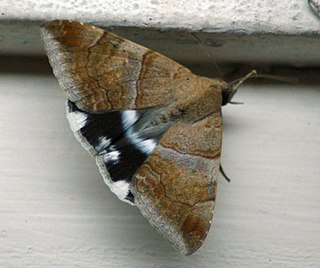
Achaea janata, the castor semi-looper or croton caterpillar, is an erebid moth, the caterpillars of which are termed 'semi-loopers' due to their mode of locomotion. It is found from the Indo-Australian tropics and subtropics, extending south to New Zealand and east through the Pacific archipelagoes to Easter Island. It is a major pest of castor throughout the world.

Tinea pellionella, the case-bearing clothes moth, is a species of tineoid moth in the family Tineidae, the fungus moths. This species has a cosmopolitan distribution, occurring nearly worldwide.
Palm oil, produced from the oil palm, is a basic source of income for many farmers in South East Asia, Central and West Africa, and Central America. It is locally used as cooking oil, exported for use in much commercial food and personal care products and is converted into biofuel. It produces up to 10 times more oil per unit area than soybeans, rapeseed or sunflowers.
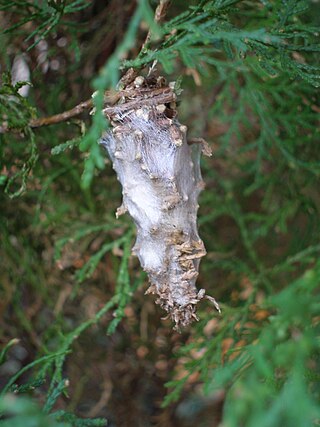
Oiketicus kirbyi is a moth of the family Psychidae. It is found in lowlands from Argentina to Mexico and on the Caribbean islands.

Tirathaba rufivena, the coconut spike moth, greater coconut spike moth or oil palm bunch moth, is a moth of the family Pyralidae. It is found from south-east Asia to the Pacific islands, including Malaysia, the Cook Islands, the Philippines and the tropical region of Queensland, Australia. They are considered as a minor pest.

Elaeis guineensis is a species of palm commonly just called oil palm but also sometimes African oil palm or macaw-fat. It is the principal source of palm oil. It is native to west and southwest Africa, specifically the area between Angola and The Gambia; the species name, guineensis, refers to the name for the area called Guinea, and not the modern country Guinea now bearing that name. The species is also now naturalised in Madagascar, Sri Lanka, Malaysia, Indonesia, Central America, Cambodia, the West Indies, and several islands in the Indian and Pacific Oceans. The closely related American oil palm E. oleifera and a more distantly related palm, Attalea maripa, are also used to produce palm oil.
The Coconut black headed caterpillar, is a species of moth found in throughout East Asian countries including Bangladesh, India, Sri Lanka, Myanmar, as well as Indonesia. It is considered a pest of coconut palm trees, causing considerable damage to the trees, and reducing the plant's yield significantly and can be a major problem where coconuts contribute to the economy. The species exists on coconut palms through its life stages from larval to moth, and utilizes the tree fronds as a main source of nutrition. Various methods of control have been explored, yet the primary control method is the administration of pesticides directly to the root of the coconut palms.
Scirpophaga excerptalis, the white top borer or sugarcane top borer, is a moth in the family Crambidae. It was described by Francis Walker in 1863. It is found in southern Asia from the Indian Subcontinent in the west to southern China in the east, south to New Guinea, possibly Australia and the Solomon Islands.
Naranga diffusa, the rice green semilooper, is a moth of the family Noctuidae. The species was first described by Francis Walker in 1865. It is found in many agricultural based countries such as Bangladesh, India, Sri Lanka, China, Hong Kong, Iran, Japan, the Korean Peninsula, Malaysia, Myanmar, the Philippines, Thailand, Taiwan and Vietnam.
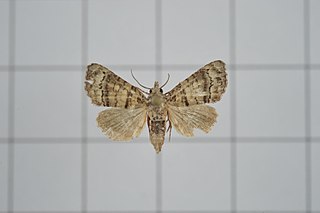
Chlumetia transversa, the mango shoot borer, is a moth of the family Euteliidae. The species was first described by Francis Walker in 1863. It is a widely distributed across Indo-Australian tropical countries far east to Solomon Islands.
Macroplectra nararia, the coconut slug caterpillar, is a moth of the family Limacodidae. The species was first described by Frederic Moore in 1859. It is found in Sri Lanka and India.

Metisa plana is a moth of the family Psychidae first described by Francis Walker in 1883. It is found in Sumatra, Malaysia and Sri Lanka. It is a major pest on Elaeis guineensis, the African oil palm.

Pteroma plagiophleps is a moth of the family Psychidae first described by George Hampson in 1892. It is found in India, Bangladesh, Sri Lanka, and Indonesia.
Mahasena corbetti, the coconut case caterpillar, is a polyphagous species of bagworm. This species is classified as leaf-eating pest caterpillars that produce tough silk out of their bags from dried foliage. Currently, M. corbetti is considered a 'pest of quarantine importance' in multiple countries and is included on the list of dangerous pests in the Malaysian plant quarantine act.











